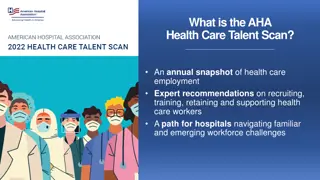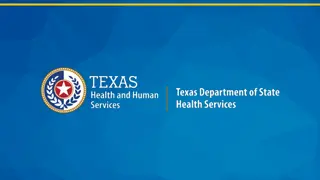
Public Health Workforce Demands and Opportunities: Addressing Challenges and Embracing Change
Explore the evolving landscape of the public health workforce, focusing on nutrition and health education. Uncover factors shaping future projections, identified change drivers, and the impact of demographic trends. Gain insights into workforce development, training patterns, and key priorities for the future. Discover how the field is adapting to meet emerging challenges and opportunities.
Download Presentation

Please find below an Image/Link to download the presentation.
The content on the website is provided AS IS for your information and personal use only. It may not be sold, licensed, or shared on other websites without obtaining consent from the author. Download presentation by click this link. If you encounter any issues during the download, it is possible that the publisher has removed the file from their server.
E N D
Presentation Transcript
Future Public Health Workforce Demands and Opportunities Jamie Stang, PhD, MPH, RDN University of Minnesota School of Public Health
If you think in terms of a year, plant a seed; if in terms of ten years, plant trees; if in terms of 100 years, teach the people. Confucius
Public Health Nutrition Workforce Development Why should we be concerned? Significant demographic changes are occurring Many state leaders are preparing to retire Shifting of health care priorities expected Treatment vs. prevention Changes in education and training are underway Increase in education to become credentialed in nutrition/dietetics Limited supervised practice has created a bottle neck Upward mobility is expected Generalist vs. specialist training
ASPHN Members: A Profile Training and credentials 77% are RDNs 20% have bachelors degree 63% have masters degree Where we work 78% work in state health department 6% at university 2% at local health department 1% at non-profit 2% at other state agency Our experience 25.5% have worked in PHN for 26 years or longer 25.5% plan to retire in next 5 years 14.5% not sure 2014 ASPHN Member Assessment Survey
Factors in Future Workforce Projections 2014 ASPHN needs assessment Obesity prevention is top responsibility Nutrition or health education next WIC is third (was top in 2012) Funding WIC still funds most positions State funds CDC Few people receive funding from HRSA/MCHB
Select Change Drivers Identified by Academys Council on Future Practice 1. Aging population drive opportunities and challenges 2. Population and workforce diversity challenges 3. Workforce education meets job market demands 4. Generalists gain edge over specialists 5. Food industry transforms for public priorities 6. Health care reform 7. Population risk factors and nutrition initiatives
A Changing Population DEMOGRAPHICS
Demographic Trends US Census Projections, 2014 2060 319 million people Will reach 400 million by 2051 1 in 5 Americans will be 65 and older by 2030 Half of Americans will be from a minority group by 2044 By 2060, 1 in 5 people will be foreign born 13% foreign born in 2014 Largest increase expected between 2010 and 2020 20% of mothers will be foreign-born by 2060 Current Population Reports, Projection of the Size and Composition of the US Population: 2014 to 2060. US Census Bureau
Demographic Trends, 2014 - 2060 US Census Projections Population <18 yr will decrease from 23% to 20% 8.4% increase among US-born 30% increase among foreign-born 18-64 yr group will decrease from 62% to 57% Percentage of both US- and foreign-born will remain fairly stable >65 yr group will increase from 15% to 24% overall More pronounced aging among foreign-born groups 7% increase among US-born older adults 15% to 22% 18% increase among foreign-born older adults 14% to 32%
Demographic Trends, 2014 - 2060 US Census Projections 44% of Americans will be non-Hispanic white in 2060 Majority minority crossover expected in 2044 Multiple race category will grow fastest 226% increase, from 2.5% to 6.2% Asian population 2nd fastest growing category 143% increase projected, 5.4% to 9.3% Hispanic population 3rd fastest growing category 115% increase, 17% to 29% Black population expected to increase by 42% Will comprise 14% of population by 2060 American Indian/Alaskan Native and Native Hawaiian and Pacific Islander populations will grow modestly About 1% of total population, each
Demographic Trends, 2014 - 2060 US Census Projections for < 18 yr population US approaching minority majority youth population Crossover will occur in 2020 2014, 52% of youth are non-Hispanic white Expected to decrease by 23% by 2060 By 2060, 64% of youth will be non-white 24% of youth are Hispanic 34% will be Hispanic by 2060 Largest growth for youth will be multiple race category 2nd largest growth rate will be Asian 3rd fastest growth rate will be Hispanic Native American/Alaskan Native and white youth populations will decrease
How Diverse is ASPHN? ASPHN Academy RDNs US White 79.1% 84% 77.7% Black 5.5% 2% 13.2% Hispanic 6.4% 3% 17.1% Asian/Pacific Islander 2.7% 5% 5.5% American Indian/Alaskan Native 2.7% <1% 1.2% Other (including > 2 races) NA 1% 2.4% Male 2.7% 4% 49.2%
How Diverse Will Nutrition and Dietetics Be? Dietetics student diversity 6% black 11% Hispanic 7% Asian/Pacific Islander < 1% Native American/Alaskan Native 75% white Enrollments among most minority groups increasing +15% Hispanic +7% Asian/Pacific Islander +20% American Indian/Alaskan Native - 1% black
Economic Trends 14.5% of Americans live in poverty 19.9% of youth live in poverty 13.6% of 18-64 yr old adults live in poverty 9.5% of older adults live in poverty Poverty rate was 22.4% in 1950s Lowest rate was 11% in 1973 Rose in 1980s to 15.2% (1983)
Economic Trends Racial and ethnic differences in poverty 9.9% white, 12.1% Asian households 27.4% black and 26.6% Hispanic households Poverty rate declined among Hispanics in 2013 Gender and nativity differences 31.6% of single female-headed households 15.8% single male-headed households 6.2% married-couple households 14.4% of households headed by US-born adult 19.9% of households headed by foreign-born adult
Economic Trends Bureau of Labor Force Projections 2012 - 2022 5.5% unemployment rate (May 2015) In 2012, 63.7% labor force participation rate 61.6% by 2022 2022, 55+ yr 26 % labor force participation rate (currently 21%) Average hourly wages $24.96 Fastest growth in less-skilled, lower paying positions Minimum wage will have an effect on poverty rates Current rate of $7.35 = $15,080 annually tipped minimum wage frozen at $2.13/hr in 1991 Adults 20+ yr make up 88% of minimum wage workers
Food Insecurity Food insecurity and hunger 14.3% of households are food insecure 5.6% very low food security (hunger) 8.7% low food security 47% of homes with food insecurity have incomes > 130% of poverty line 19.5% of households with children are food insecure 13.9 million children are in food insecure homes 3.3 million children are in homes that experience hunger Households with children 2x as likely to experience food insecurity Children from food insecure homes more likely to have poor health status, anemia, lead poisoning, behavioral issues
Demographics of Food Insecurity
We Care About Our Food FOOD TRENDS
Consumer Demands for Food Organic foods 4% of all food sales $35 billion (2014) Fruits and vegetables largest category Dairy is second largest category Packaged/prepared foods is third Conventional stores are the main source of organic foods 93% sold in conventional/natural food stores 7% in formers markets Cost difference is <30% for most foods Blueberries > 100% premium Dairy premium was 60% to 110%
Consumer Demands for Food Specialty foods Gluten free $1.8 billion market in US Expected to be $23.9 billion in 2020 Raw milk Caused 81 food borne illness outbreaks in 26 states between 2007 and 2012 Campylobacter 81% of outbreaks E-coli (shiga toxin-producing) 17% of outbreaks Salmonella 3% of outbreaks 59% of outbreaks involved children < 5 yr Sales of some sort legal in 30 states
Consumer Demands for Food Sustainable, local foods US Congress 2008 Food, Conservation and Energy Act defined locally or regionally produced agricultural food products as < 400 miles from origin or within the State in which it was produced Most consumers disagree with 100 mile radius for produce Local foods chosen for freshness (82%), supporting local economy (75%), knowing food source (58%) Price was only considered an issue by 16% of consumers No differences by income, education, race/ethnicity
Trends in Local Foods Direct to consumer marketing $1.2 billion in 2007 Was $551 million in 1997 Accounted for almost 1% of agricultural sales in 2007 5,274 farmers markets in 2009 Was 2,756 in 1998 and 1,755 in 1994 1,144 CSA in 2005 Was 400 in 2001
Local and Regional Food Systems 8% of US farms (163,675) marketed foods directly to consumers in 2012 70% used only CSA or farmers market channels 17% increase in number, 32% increase in sales 2002-2007 Local food sales estimated at $6.1 billion in 2012 85% of local food farms had < $75,000 in gross income in 2012 13% of food sales 5% of local food farms had > $350,000 gross income accounted for 67% of sales USDA. Trends in US Local and Regional Food Systems: Report to Congress. Jan 2015
Farm to School 4,322 School districts (44%) 23.5 million children Local of food 21% within 50 miles 13% get foods within 100 miles 6% within 200 miles 26% within state $385.8 million spent on local foods 78% fruit 75% vegetables 37% milk 22% baked goods
Health Care Reform and Public Health POPULATION RISK FACTORS
Snapshot of Health Care CVD is leading cause of mortality 24% of women, 11% men > 65 yr have high cholesterol Cancer second leading mortality cause Stroke is 3rd leading cause of death 32% of adults 45-64 yr have hypertension 51% of adults 65-74 yr have hypertension Chronic lower respiratory disorders is #4 Unintentional injury is #5 Diabetes is #6 11% of adults 20+ yr have diabetes 7% of teens, 26% of adults have pre-diabetes
Snapshot of Health Care Limitations of activity affect many people 9% of youth Learning disabilities, neuro-behavioral disorders, neuro-muscular conditions, hearing and vision disorders, speech disorders, intellectual disability 25% of adults aged 18-64 Mental illness, diabetes, pulmonary disease, musculoskeletal disorders, intellectual disability, hearing and vision disorders 62% of adults aged 65+ (living at home) Musculoskeletal disorders, diabetes, dementia, heart disease, pulmonary disease, hearing and vision loss
Insurance Trends Patient Protection and Affordable Care Act aka, Obamacare or the ACA goals Provide coverage for uninsured Americans Improve affordability and stability of insurance for those already insured Slow health care cost growth to reduce the federal deficit Additional reforms Shift health care costs from treatment to prevention Free, annual wellness checkups Wellness incentives for reducing weight and cholesterol, smoking cessation, etc Increased availability of telemedicine Increase in community health centers Domestic Policy Council, March 23, 2015
The ACA Five Years Later 16.4 million more people have insurance Uninsured rate decreased 9% among black and 12% among Latino adults 40% decline in uninsured young adults through expanded dependant coverage through age 25 129 million people with pre-existing conditions could not be denied coverage 17 million children 105 million people no longer have lifetime cap Consumers saved $9 billion Insurance companies required to spend 80 per dollar of premium cost on care Domestic Policy Council, March 23, 2015
The ACA Five Years Later Lowest increase in employer premiums since 1999 $1800 per family in savings for employers Hospital Insurance Trust Fund (Medicare) will remain solvent for 13 additional years (until 2030) Reductions in health care costs 424 Accountable Care Organizations serve 7.8 million 20% Medicare reimbursements linked to health and well-being of patients 9.4 million people on Medicare saved $15 billion on prescription drugs $1,598/person Domestic Policy Council, March 23, 2015
Health and Disease Trends Overweight and obesity will continue to be major chronic health condition Co-morbid condition with many chronic conditions Plateau in obesity a promising sign Funding for policy, system, environmental change strategies contingent on evidence of effectiveness Telling our stories is important for policy and funding 75% of health care spending for chronic diseases 3% is spent on public health and primary prevention 84% spent on physician-related care Medication Hospitalization Outpatient surgical procedures
A Snapshot of the Nutrition Workforce PUBLIC HEALTH AND COMMUNITY NUTRITIONISTS
Definitions: Public Health & Community Nutrition Community Nutrition Community nutrition encompasses individual and inter-personal level interventions that create changes in knowledge, attitudes, behavior and health outcomes among individuals, families or small, targeted groups within a community setting. Community Nutritionist Professional trained in the delivery of primary, secondary and tertiary nutrition services within community settings. Has training in Nutrition throughout the lifespan Nutrition education and counseling Program development
Definitions: Public Health & Community Nutrition Public Health Nutrition The application of nutrition and public health principles to design programs, systems, policies, and environments that aim to improve or maintain the optimal health of populations and targeted groups Public Health Nutritionist Professional trained in both nutrition and the core competency areas of public health Biostatistics, epidemiology, health behavior, health policy and management, and environmental science. Has advanced didactic and experiential training in public health nutrition or holds advanced degree in public health nutrition or nutrition science
Public Health vs Community Nutrition Public Health Nutrition Community Nutrition Primary audience Populations (cities, counties, states, regions, countries) Individuals, families, groups, communities Levels of prevention Primary, some secondary Secondary and tertiary Provision of direct services Limited or no direct service involvement Primary responsibility Policy & advocacy roles Development, evaluation, revision, monitoring Advocate for change, implement policies Nutrition program & service roles Development, evaluation, revision, administration Assessment, implementation, limited role in other functions Research & evaluation Nutrition surveillance, design and analysis, reporting Data collection, assist with design and reporting Management responsibilities Financial, personnel, departmental-level staffing and succession planning Supervision of program employees, limited other roles
Public Health and Community Nutritionists More than half of nutrition and dietetics (RDN) positions are in clinical nutrition 22% in-patient care 18% out-patient care 11% long-term care 11% on community nutrition 4% on other including public policy and advocacy
Two roads diverged in a wood, and I I took the one less traveled by, And that has made all the difference. Robert Frost
Public Health/Community Nutrition Workforce 91,889 RDNs 11% report community nutrition as primary area of practice Half of RDNs have a masters/graduate degree Median pay for RDN is $28.85/hr Median pay for community nutrition is $26.06/hr Lowest of all practice areas 7% increase in pay between 2011 and 2013 for WIC nutritionists Median pay for PHN is $27.50/hr 2% increase in pay for public health nutritionists Commission on Dietetic Registration/Academy, 2013 Compensation and Benefits Study
Hourly Wages of RDNs 25th percentile 50th percentile 75th percentile Position Average of All Practice Areas $24.04 $28.85 $34.86 Community Nutrition $21.87 $26.06 $31.25 WIC Nutritionists $19.71 $24.04 $28.21 Public Health Nutritionists $23.08 $27.50 $34.98 Cooperative Extension Educator/Specialist $20.09 $25.00 $31.45 School/Child Care Nutritionist $20.83 $28.85 $34.98 Head Start Nutrition Coordinator $19.91 $25.41 $31.58 Food Bank/Assistance Program Nutritionist $21.68 $24.04 $29.81
Workforce Supply and Demand HRSA Workforce Projection: Dietitians & Nutritionists Between 2012 and 2025 Supply expected to increase by 36% Demand projected to grow by 20% Projected surplus of 10,400 FTEs by 2025 Bureau of Labor Statistics Occupational Outlook Handbook Between 2012-2022 Demand will increase by 21% (faster than average) Commission on Dietetic Registration Dietetics Supply and Demand: 2010-2020 Annual growth rate of 1.1% Only 75% of demand met by 2020 Shortfall of 18,000 FTEs
Professional Attrition Rate Nutrition and dietetics has a 2% to 5% attrition rate Retirement Extended/permanent leave for family, personal reasons Continued education into another field Leave the field for higher paying positions 75% of nutrition and dietetics professionals work full time (> 35 hr/week) 25% work 20 hr/week or less Unknown number drop out of the workforce temporarily for personal/family issues
Uneven Distribution of Professionals State N = RDN/100,000 population Rank Top 8 North Dakota 356 55.0 1 New Hampshire 480 36.2 2 Minnesota 1,894 36.0 3 Nebraska 641 35.7 4 Massachusetts 2,287 34.7 5 Vermont 209 33.6 6 Connecticut 1,179 33.5 7 Wisconsin 1,875 33.2 8 Bottom 5 Florida 3,644 19.7 46 Georgia 1,879 19.1 47 South Carolina 870 19.1 48 West Virginia 310 17.0 49 Nevada 422 16.0 50
Bifurcation of the Health Care Workforce Greatest growth in lowest education sectors Community health workers Home health aids Assistant or technician roles Growth in advanced degree positions uncertain Administrative or managerial positions Interprofessional roles Stagnation or reduced demand in BS-prepared professionals Care systems will look for those with lower salaries and those with advanced, interprofessional skills
Changes in Nutrition and Dietetics Education Commission on Dietetic Registration will require a graduate degree to sit for the national RDN registration exam by 2024 Can be in any field as long as nutrition and dietetics coursework and supervised experience requirements are met Does not matter if supervised practice occurs before, during or after graduate degree coursework BS, internship, graduate degree BS, coordinated graduate degree program BS, graduate degree, internship
Nutrition and Dietetics Training Currently 575 accredited nutrition and dietetics programs in the US and international settings ACEND-credited programs N US Dietetic Technician Programs 42 US Coordinated Programs 57 US Didactic Programs 224 US Dietetic Internships 252 International Coordinated Programs 5
ACEND Proposed Changes in Education and Training for Nutrition and Dietetics Move RDN education to masters degree Move NDTR education to bachelor s degree Pathway III (2556 took exam; 45% of those eligible) Create associate-degree credential Community Nutrition and Health Assistant New competencies for each level of education Experiential learning integrated into all education Career laddering where one degree can be built upon another Future exploration of high school and doctoral level programs
ACEND Report Highlights Communication skills are an essential and under- developed part of nutrition/dietetics training Employers expect strong organizational leadership and project management skills Supervised practice is highly valued but the accessibility and quality vary tremendously
Supervised Practice Shortage 52% of graduates who apply match with an internship Supervised practice spots fiercely competitive Clinical nutrition is hardest in most areas Individualized Supervised Practice Pathways (ISPPs) Sept 2011 launch, aimed at DPD programs DPD graduates who do not match with an internship Doctoral-degree holders without DPD verification Allow 24 months to complete rotations Most programs have students locate own preceptors Much less oversight than traditional programs
Broad Education Improves Career Prospects Roles specific to nutrition may not be preserved Critical skills areas Program planning and evaluation Surveillance and monitoring Program administration and management Oral and written communication Degrees that provide these skills MPH Biostatics, epidemiology, health behavior, healthcare management and administration, environmental health Bioethics Others ??? MEd, MHA, MS, MPP






















